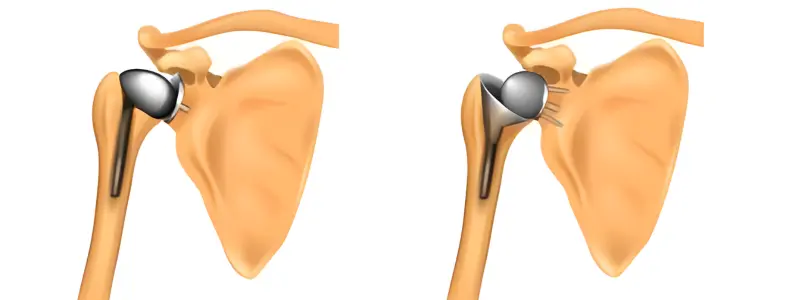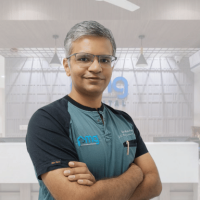PMG Hospital is best orthopedic hospital in Ahmedabad for knee replacement, hip replacement, Trauma surgeries & Arthroscopy treatments

Shoulder replacement or arthroplasty surgeries are performed to restore the functionalities and stability of joints by removing and replacing bone fragments with artificial implants or prostheses.
Revisional Shoulder Replacement is replacing old prosthetic or artificial implants with other prosthetics using specialized tools and techniques for better and long-lasting results.
Revisional Shoulder Replacements are different and more complex than primary Shoulder Replacements as they require specialized implants, planning, and orthopedic surgical expertise.
A candidate for total shoulder replacement is typically someone who experiences severe shoulder pain and stiffness that limits daily activities and doesn’t respond to other treatments. Common conditions that might lead to this surgery include:
Patients who haven’t found relief through medications, physical therapy, or less invasive procedures may consider total shoulder replacement. The decision is usually based on the level of pain, disability, and the impact on the patient’s quality of life.
Total shoulder replacement surgery involves removing the damaged parts of the shoulder joint and replacing them with artificial components to restore function and relieve pain. The procedure typically includes replacing the head of the humerus (upper arm bone) with a metal ball and resurfacing the socket (glenoid) with a plastic component.
The procedure of total shoulder replacement (TSR) generally follows these steps:
Preparation and Anesthesia: The patient is given anesthesia, either general (putting the patient to sleep) or regional (numbing the arm and shoulder area).
Incision: The surgeon makes an incision over the shoulder to access the joint. This incision can vary in length depending on the specific technique used.
Removal of Damaged Bone and Cartilage: The surgeon removes the damaged cartilage and bone from the humeral head and the glenoid socket.
Implantation: The surgeon inserts a metal ball attached to a stem into the humerus. The stem is often cemented into place. The glenoid cavity is resurfaced with a plastic socket, which may be cemented or press-fitted.
Closure: The surgeon closes the incision with sutures or staples and covers it with a sterile bandage.
Recovery: The patient is taken to a recovery area for monitoring. Post-surgery, the patient begins a rehabilitation program, including physical therapy, to regain strength and mobility in the shoulder.
The main difference between total shoulder replacement and partial shoulder replacement lies in the extent of the joint replacement and the components used:
Total Shoulder Replacement (TSR):
Partial Shoulder Replacement (PSR):
The choice between total and partial shoulder replacement depends on the extent of the damage to the shoulder joint and the specific condition being treated. An orthopedic surgeon will assess the patient’s condition and recommend the most appropriate procedure.
The cost of total shoulder replacement can vary widely depending on several factors, including the country and region where the surgery is performed, the specific hospital or surgical center, the surgeon’s fees, and any additional medical expenses.This estimate generally includes the surgeon’s fee, hospital stay, anesthesia, pre-surgery consultations, and post-surgery physical therapy. Insurance coverage can significantly affect the out-of-pocket cost for patients, so it is important to check with your insurance provider for specific details regarding coverage and potential expenses.
The Three types of implants for total shoulder replacement (TSR) vary based on the materials used, the design, and the fixation method. Here are the main types:
Yes, both shoulders can be replaced at the same time in a procedure known as bilateral shoulder replacement. However, this is less common than bilateral knee replacements due to the following considerations:
Complexity and Duration: Replacing both shoulders in a single surgery is complex and requires a longer surgical time, which can increase the risk of complications.
Recovery and Rehabilitation: Recovery from bilateral shoulder replacement can be challenging. Patients would need to manage their daily activities without the full use of both arms during the initial recovery period, making tasks such as dressing, eating, and personal hygiene more difficult.
Staged Approach: More often, shoulder replacements are done in stages, with the surgeries spaced several months apart. This allows the first shoulder to heal and regain strength before the second surgery, making the overall recovery process more manageable.
Health and Fitness: The decision to perform bilateral shoulder replacement at the same time depends on the patient’s overall health, fitness level, and ability to withstand a prolonged surgery and recovery period.
The lifespan of a shoulder replacement can vary depending on various factors, including the patient’s age, activity level, the type of implant used, and the underlying condition being treated. On average, a shoulder replacement can last between 15 to 20 years or more. Advances in surgical techniques and implant materials have improved the longevity of shoulder replacements, and many patients experience functional and pain-free use of their artificial shoulder for two decades or longer. However, factors such as excessive wear, implant loosening, or bone loss over time may necessitate revision surgery to replace or repair the implant. Regular follow-up with an orthopedic surgeon and adherence to post-operative care and rehabilitation guidelines can help maximize the lifespan of a shoulder replacement.
Our Services

Total Shoulder Replacement Surgeon in Ahmedabad, Gujarat
Putting the patient first is the only philosophy we believe in at PMG Hospital. Practicing knee replacement surgeries for more than one decade we always tried to prescribe the most effective and essential surgeries like partial knee replacement over total knee replacement if it is the only required as per the patient’s medical conditions.
PMG Hospital is best orthopedic hospital in Ahmedabad for knee replacement, hip replacement, Trauma surgeries & Arthroscopy treatments